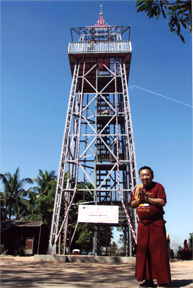 The International Peace Pagoda Project (IPPP) is a Buddhist construction project to promote world peace, universal healing, international harmony, & enlightenment.
The International Peace Pagoda Project (IPPP) is a Buddhist construction project to promote world peace, universal healing, international harmony, & enlightenment.
In Dr. Aung’s own words…
I would like to introduce the Venerable Sayadaw U Thila Wunta who has contributed so much with respect to this precious perspective. He was my teacher when I was a child growing up in Rangoon, Burma (now called Yangon, Myanmar). In those early days, in the 1950s and 1960s, he was an eminent Buddhist monk, while I was a very young student of the Dharma. The Venerable Sayadaw’s teaching endeavours are centred in the Dat Pon Zon Aung Min Guang Monastery (named after the Venerable Sayadaw’s teacher) in Yangon. I left Myanmar in the early 1970s, immigrating to Canada to pursue my integrative medical career. I temporarily lost direct personal contact with the Venerable Sayadaw, but maintained the spiritual (karma) link over the years by following his Buddhist teachings. In April 1986, our karma paths/links crossed once again directly. I was honoured to meet with the Venerable Sayadaw, when he came to Edmonton, Alberta, Canada and constructed a stupa at my home, in my backyard.
Constructing stupas is the Venerable Sayadaw’s vision and mission in life, which was given to him by his eminent Buddhist teacher, mentor and master, the Venerable Bodaw Aung Min Guang. The term ‘stupa’ derives from the ancient Sanskrit language, meaning the crown of one’s head. A stupa, a dome-shaped monument, may be a large and elaborate or just a simple humble village pagoda. Whatever the exact shape, size, place, position or monetary worth, a stupa is a vehicle/structure for enfolding and housing precious relics in commemoration of Buddhism in the interest of promoting world peace, harmony and healing. These relics represent samadhi — the most pure crystallization and fruit of devout prayer and meditation in the sprit of universal compassion cultivated by various eminent monks/masters and their devoted students over many years, decades, centuries and millennia. The Venerable Sayadaw has constructed many stupas, mainly in Myanmar, but also in several other countries such as Canada, Australia, New Zealand and South Africa. He carefully selects a suitable site based on the positive ‘spirit of place’(in traditional Chinese medicine this is termed good Feng Shui).With his assistants and supporters, he arranges for a local group to help in the construction of the stupa by supplying the stone, bricks, mortar, lime, wood, water and other basic building materials. He masterminds the construction of the stupa within a couple of weeks with the heartfelt help of a charitable group.During the construction phase, he meditates and chants mantras, sending mingala (positive healing energy) to the environment. After the stupa has been built and the relics have been properly selected and placed, he relies on volunteers to maintain the site as a centre of healing energy for the benefit of all sentient beings.
For example, on Galiano Island, British Columbia, Canada, the Crystal Mountain Buddhist group constantly maintains the stupa that the Venerable Sayadaw constructed in 1982 (www.crystalmountain.org). He is also the guiding light with respect to the Dharma Centre of Canada in Kinmount, Ontario (www.dharmacentre.org) and the Wangapeka Study and Retreat Centre in New Zealand (http://www.wangapeka.org)
As for myself, my family and our friends and colleagues, we constantly maintain the stupa that the Venerable Sayadaw constructed at my home in Edmonton. It was my honour to continue and keep my childhood commitment to help the Venerable Sayadaw construct a stupa in South Africa in a carefully selected locale near Cape Town, namely, Barrydale (www.barrydale.co.za/activitiesframe.htm) in December 2000, Brazil in 2006 and in Myanmar in 2008 & 2015.